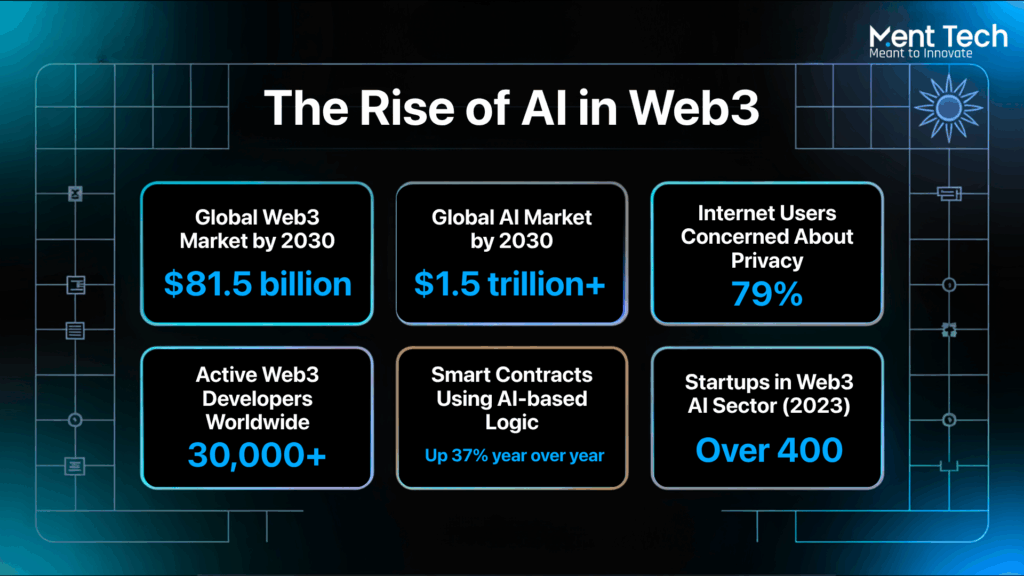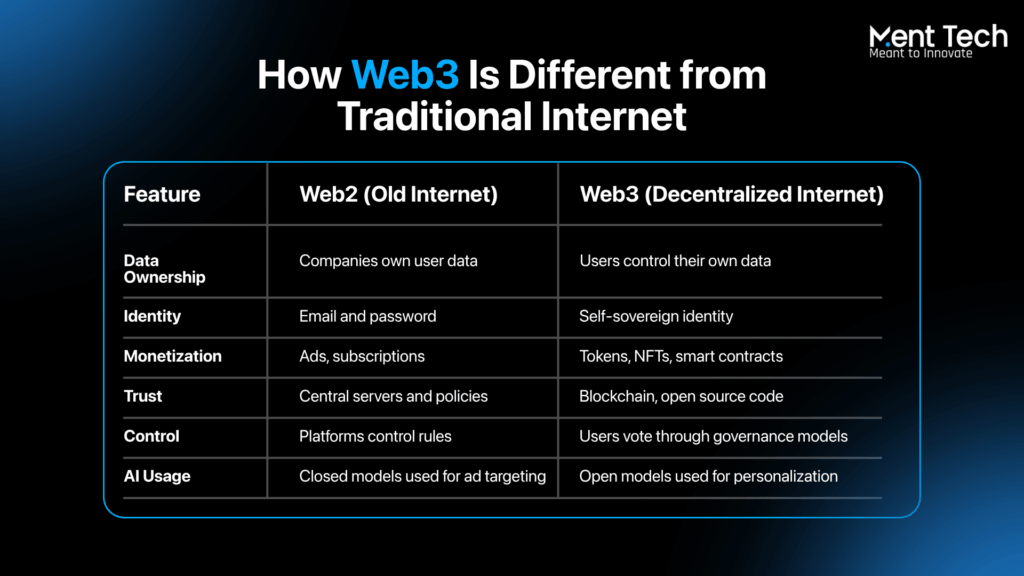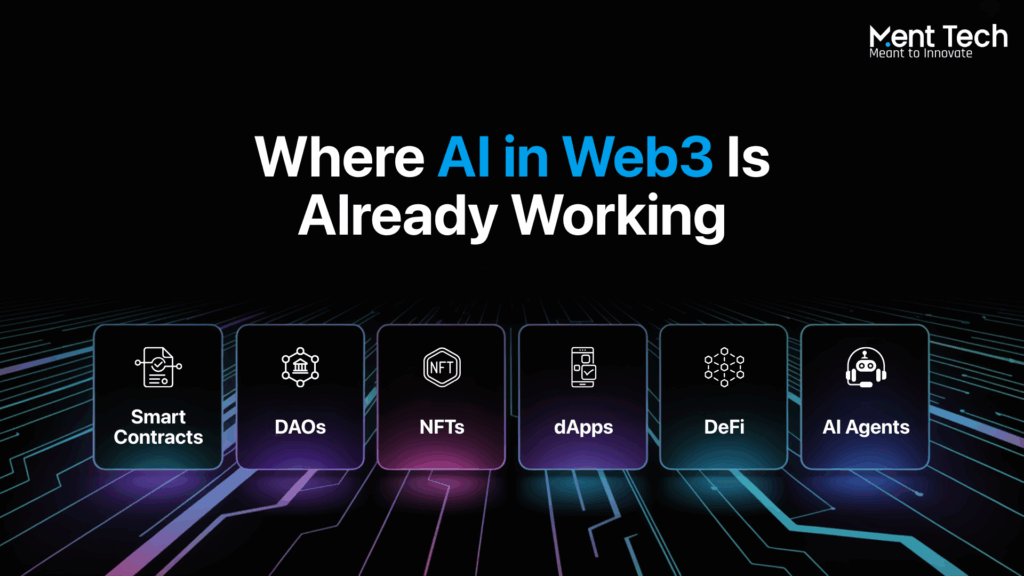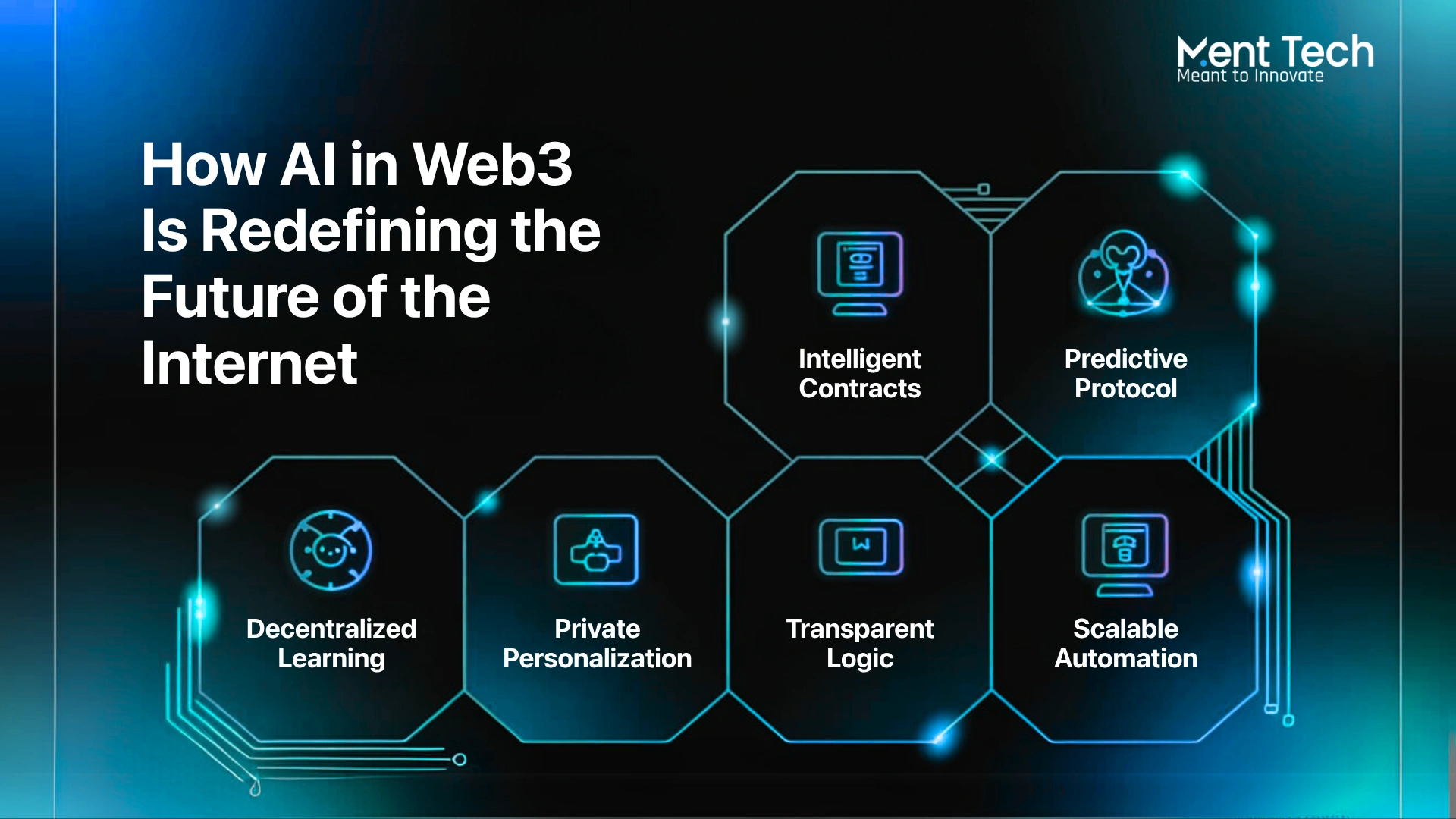More than 5 billion people use the internet today, but nearly 80 percent lack control over how their data is collected or used. At the same time, artificial intelligence shapes everything from shopping recommendations to financial decisions, yet most systems remain closed, opaque, and unaccountable.
This is where AI in Web3 steps in. The convergence of blockchain infrastructure and intelligent models is building a smarter, transparent, and user-owned internet. By putting data and decision-making in the hands of users, it moves beyond the limits of Web 2.
The growth potential is massive. By 2030, AI is projected to contribute $15.7 trillion to the global economy, while the Web3 AI market alone could exceed $100 billion. Intelligent smart contracts and decentralized data agents are no longer futuristic; they’re already shaping real platforms.
Web2 delivered convenience, but Web3 AI delivers something deeper. It brings ownership, personalization, and genuine trust, creating a digital ecosystem that is faster, safer, and truly user-first. The future isn’t on the horizon; it’s unfolding right now.
At Ment Tech Labs, we work at the intersection of these two forces, helping clients build decentralized products with real intelligence, speed, and market impact.

What Is Web3 and Why It Matters?
Web3 represents the next-generation internet built on decentralization, giving users control over their data, identity, and digital assets. It reduces reliance on centralized platforms and enables direct, trustless interactions between participants. This shift empowers individuals while creating new opportunities for innovation and collaboration, and a clear web3 go-to-market strategy.
By design, Web3 ensures transparency and security through blockchain technology, allowing users to verify transactions and interactions independently. Its open and permissionless nature encourages wider participation and fosters a fairer distribution of value. The result is a more user-centric ecosystem that prioritizes control, privacy, and ownership.

Key features of Web3 include:
1. Decentralization – Data and control are distributed across networks, reducing dependence on centralized entities and promoting resilience.
2. User Ownership – Individuals have full control over their data, content, and digital assets, enabling true digital autonomy.
3. Transparency – Public protocols and smart contracts ensure all actions are verifiable and visible to participants.
4. Permissionless Access – Anyone can participate without restrictions, fostering open innovation and inclusivity.
5. Interoperability – Platforms and applications can seamlessly communicate, creating a connected and cohesive ecosystem.
6. Enhanced Security – Blockchain ensures data integrity and protection against fraud or unauthorized tampering.
AI’s Role in Building Smarter Web3 Platforms
The integration of AI into Web3 is redefining decentralized ecosystems, making them more intelligent, secure, and user-centric. By combining machine learning, predictive analytics, and blockchain infrastructure, platforms can deliver personalized experiences, automated operations, and actionable insights while moving beyond the limitations of Web2.
1. Intelligent Blockchains
AI enhances blockchain scalability, predicts transactions, and detects fraud. By embedding intelligence into protocols, networks become faster, safer, and more adaptive for both users and developers.
2. Smarter Smart Contracts
Smart contracts evolve into AI-driven decision-making systems. They can analyze real-time data, forecast outcomes, and adjust actions automatically, ensuring transactions are more efficient, reliable, and responsive.
3. AI-Powered dApps
Decentralized applications gain interactivity and personalization through AI. From adaptive NFTs to intelligent recommendations, dApps can respond to user behavior, creating engaging and immersive digital experiences.
4. Intelligent DAOs
AI streamlines governance in decentralized organizations. By analyzing proposals, predicting outcomes, and optimizing resource allocation, DAO development enhances transparency, efficiency, and responsiveness to community needs.
5. Decentralized AI Models
Distributed AI models operate across networks while preserving privacy. This collaborative approach reduces reliance on centralized systems and powers scalable, intelligent Web3 solutions for diverse platforms.
6. Enhanced Security and Insights
AI strengthens security by detecting threats and anomalies while protecting user data. It also generates actionable insights from complex datasets, helping platforms run smarter, safer, and more reliably.
7. Operational Efficiency and Growth
AI automates processes, optimizes resource allocation, and uncovers trends from large datasets. Platforms can scale efficiently, reduce operational costs, and make data-driven decisions to drive growth and innovation.
Real-World Use Cases of AI in Web3
The fusion of AI in Web3 is not limited to theory. It is already being used to create real products, automate decision-making, and secure decentralized networks. As developers look beyond traditional app models, Web3 AI solutions are becoming the foundation for smarter, self-governing systems.
Here are six use cases that show how artificial intelligence in Web3 is transforming how we build and interact with digital tools.
1. Smart Contracts That Learn
AI can help smart contracts go beyond static codes. With Web3 AI, contracts can assess risk, adjust logic based on external data, and detect anomalies before execution. This feature improves both performance and security for on-chain transactions.
2. Intelligent DAOs
Decentralized Autonomous Organizations are evolving. With AI models analyzing vote outcomes, proposal quality, and member behavior, DAOs become more effective and less prone to manipulation.
3. AI-Driven NFT Logic
NFTs can now evolve with user interaction. From dynamic metadata to AI-generated artwork, creators are using Web3 AI to build responsive digital assets with real-world value.
4. Personalized dApps
Using artificial intelligence in Web3, decentralized apps can now tailor their interface, content, and features to individual users without tracking them across the internet. This creates better engagement while protecting privacy.
5. Predictive DeFi Tools
AI models can analyze liquidity, volatility, and user activity in real time. This allows DeFi platforms to optimize lending rates, detect threats, and suggest better investment strategies.
6. Decentralized AI Agents
Autonomous agents built on blockchain infrastructure can operate without central servers. These agents handle tasks like customer service, trade execution, or content moderation while keeping data and logic on-chain.
From NFTs to DeFi, from DAOs to digital identity, AI in Web3 is making decentralized systems more useful, scalable, and user-first.

AI Across the Web3 Stack
To understand how AI in Web3 works in practice, you need to look at the layers that make up the Web3 stack. From the base blockchain to the application interface, each layer offers unique opportunities for intelligent automation and decision-making.
This is where Web3 AI development gets real. Instead of just adding AI tools on top, developers are embedding intelligence directly into the core architecture of decentralized systems.
Here is how it works across three essential layers.
1. Blockchain Layer
This is the foundation. Blockchain provides the security, transparency, and consensus mechanisms that power Web3. When you add artificial intelligence in Web3 at this level, the network becomes smarter at fraud detection, anomaly monitoring, and governance control.
- AI can monitor mempool data to predict high-risk transactions
- Intelligent models can flag suspicious activity before it hits the chain
- AI-based consensus models can adapt voting power to improve fairness
2. Protocol Layer
Protocols handle logic, data exchange, and network rules. In Web3 AI solutions, this layer becomes more dynamic when machine learning is used for liquidity tracking, credit scoring, and token price forecasting.
- DeFi platforms can adjust lending rates using predictive models
- Gaming protocols can customize in-game economies in real time
- Cross-chain bridges can detect inconsistencies and prevent exploits
3. Application Layer
This is what users interact with. dApps, wallets, and platforms run here. With Web3 AI, applications can personalize content, predict intent, and offer autonomous features that work within user-owned systems.
- Chat interfaces can respond using natural language models
- NFTs can change based on user engagement or performance
- Marketplaces can surface relevant tokens or assets based on behavior
At MentTech Labs, we build AI-ready infrastructure across all three layers. Our team works closely with product leads and protocols to develop full-stack Web3 AI solutions tailored for performance, scale, and compliance.
When artificial intelligence becomes part of the Web3 stack, it turns infrastructure into intelligence and logic into value.

How Web3 Solves Key AI Challenges?
AI offers immense potential, but it also faces challenges that limit trust, fairness, and effectiveness. Web3 provides solutions by combining decentralization, transparency, and secure data handling, enabling smarter and more accountable AI systems. Several AI startups are exploring these approaches to improve reliability and fairness.
1. Transparent AI with Web3
AI systems are often opaque, making it hard to understand how decisions are made. Web3 integrates logic into smart contracts visible on-chain, allowing anyone to audit and verify AI decision-making.
2. Reducing Bias in AI Models
AI models trained on limited or biased data can produce unfair outcomes. Web3 enables diverse and auditable datasets, improving fairness and reliability in predictions and decision-making.
3. Securing AI-Generated Content
AI-generated content, including deepfakes, can be difficult to verify. Web3 ensures authenticity by time-stamping content and linking it to verified identities or smart contracts.
4. Protecting User Privacy in AI Systems
Traditional AI often requires centralized access to personal data. Web3 allows data to remain with the user while enabling local or secure learning, ensuring privacy and control.
5. Preventing AI Cybersecurity Threats
AI systems are vulnerable to attacks that can manipulate outputs. Web3 protocols provide trustless and secure networks, making it harder for adversaries to compromise AI computations.
6. Building Trustworthy AI Platforms
By addressing transparency, bias, privacy, and security, Web3 creates AI systems that are accountable, user-centric, and aligned with real human values. Businesses can now deploy intelligent solutions that users can trust.
Future Trends of AI in Web3
As Web3 evolves, artificial intelligence is shaping smarter, more secure, and user-centric decentralized platforms. By integrating AI with blockchain and dApps, systems are becoming adaptive, efficient, and personalized, with many adopting an AI agent framework to enhance automation and decision-making. Here’s a look at the emerging trends:
1. Decentralized AI Networks
AI models are being trained and deployed across distributed networks, ensuring privacy, security, and transparency. Users can actively participate in improving network intelligence while maintaining control over their data.
2. Smarter AI-Powered Smart Contracts
Next-gen smart contracts will adapt dynamically using AI insights. They can adjust terms based on real-world data, making decentralized transactions more efficient, reliable, and responsive.
3. Hyper-Personalized Experiences
AI enables decentralized apps to analyze user behavior and preferences, delivering tailored content, recommendations, and services. This creates more engaging, user-centric experiences.
4. AI-Enhanced Oracles
Oracles linking blockchains to real-world data gain reliability through AI. They can verify, validate, and adjust to changing data sources, improving accuracy and trust in decentralized applications.
5. AI for Security and Decentralized Identity
AI strengthens identity verification and safeguards user data. Behavioral patterns, biometrics, and contextual insights make decentralized identities more secure and seamless.
6. Community-Governed AI
AI systems are increasingly managed by decentralized communities via DAOs. This promotes transparency, inclusivity, and alignment of AI solutions with Web3 community values.
Final Words
AI is rapidly becoming the backbone of Web3, powering everything from smart contracts to decentralized identity systems. This convergence is not a distant possibility but a present reality, shaping how the internet evolves. The opportunity now lies in building intelligent systems that remain secure, transparent, and user-owned.
For businesses and creators, this shift is more than technical; it’s structural. It opens doors to new products, smarter ecosystems, and fairer models of digital ownership. MentTech, a leading Web3 development company, can help transform these possibilities into solutions that scale and adapt in real time.
The future of Web3 with AI will be defined by those who act early and build responsibly. Connect with MentTech today and embark on a journey towards a more intelligent, decentralized future.
FAQs
1. What is AI in Web3?
AI in Web3 refers to using artificial intelligence within decentralized networks. It enables dApps, smart contracts, and DAOs to learn, adapt, and automate without centralized control.
2. How does artificial intelligence work in Web3 applications?
In Web3 applications, AI integrates at the smart contract or protocol level, enabling personalization, predictions, fraud detection, and real-time automation with transparency. Adaptive AI Solutions enhance these capabilities with added flexibility and performance.
3. Why are businesses investing in Web3 AI development?
Companies adopt Web3 AI development to automate decisions, deliver personalization, and build trust. It combines transparency, security, and decentralized ownership for a competitive edge.
4. What are the main use cases of AI in Web3?
Key applications include AI-powered smart contracts, DeFi development tools, personalized dApps, dynamic NFTs, intelligent DAOs, and on-chain support agents for efficiency and engagement.
5. Is AI in Web3 secure for enterprise use?
Yes. Blockchain secures data, and smart contracts enforce logic, while AI enhances adaptability and minimizes risks of fraud or manipulation.
6. How can I start building with Web3 AI?
Define your goals and where automation fits, then partner with Ment Tech Labs, a leading Web3 development company, for design, infrastructure, model training, and smart contract integration.


